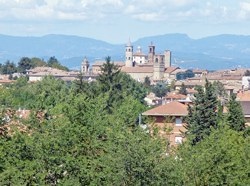


Città di Castello is situated in the Upper Tiber Valley, on the left bank of the river near the Tuscan border. In the 1st century AD, Pliny the Younger had an estate and magnificent nearby and acted as the patron of what was then Tifernum Tiberum. The city grew rich on its fertile soil. It enjoyed political stability and prosperity under the Vitelli family from 1482 until 1503, when it became an important centre for Renaissance art. It then came under papal domination, but the Vitelli still wielded great influence throughout the 16th century. It then began a steady decline, and was among the poorest of the Umbrian cities by the 19th century. Perhaps this is why it was at the forefront of the anti-papal dissent that preceded the unification if Italy in 1860.
Although all three of the altarpieces that Raphael painted for the city have been dispersed, it still houses the best art collection in Umbria after Perugia. It is not in the least touristy, but there is still lots for you to see. The city is particularly lively on Thursdays, which are market days.
The annual music festival known as the Festival delle Nazioni is of international class.
Transport
There is a bus from Rome at 16:00, which takes 4 hours. The bad news is that the return bus leaves Città di Castello for Rome at 05:30.
A better bet is to travel via Perugia, using the Ferrovia Centrale Umbra (FCU). The station is an easy walk from the city centre, even if you have suitcases. However, if you want a taxi, you should probably book one in advance; Rita Saberogi, whose is usually on the rank in Piazza Matteotti, can be reached on 075 855 4406.
Hotels
I have only tried one hotel in Città di Castello, the excellent Hotel Tiferno, which is at the heart of the city (13 Piazza Raffaello Sanzio).
Residenza Antica Canonica (23 Via San Florido) also looks to be an attractive and convenient place to stay.
If you have a car and would like to stay in a rural setting, you will love Palazzo Majo, 20 km south of Città di Castello. It makes a great base for exploring northern Umbria.
Restaurants
I had really nice meals at the following during my recent visits (August 2013 and April 2014);
-
✴Caffè Accademia, 1 Via del Modello, behind Palazzo dei Priori (although this was closed during my trip in 2014, I hope not permanently)
-
✴Il Grottino, 4 Via di Bindo, off Via XI Settembre, which has a shady garden
-
✴Trattoria Lea, 38 Via San Florido
-
✴il Fiorentino, 55 Via San Florido, which specialises in steak
-
✴Trattoria Pappa e Ciccia, 16 Via del Popolo
-
✴Le Logge, 3a Piazza Matteotti, the restaurant of Hotel Tiferno, in the loggia of Palazzo Bufalini
The following wine bars also serve good food:
-
✴Enoteca Syrah, 7 Via Sant’ Antonio
-
✴Vineria del Vasaio, Piazzetta del Vasaio (signed on Via del Popolo)
Other good places for pizza or casual lunches include:
-
✴Pizzeria Trattoria L' Osteria, 1a Via Borgo di Sotto
-
✴Rosticceria Bar Trattoria Locchi, 5 Via del Popolo
-
✴Ristorante Pizzeria da Gino, next to it, which has outside tables in Largo del Buonconsiglio
Bars

-
✴for breakfast:
-
•Caffè Cavour, 4 Corso Cavour, in the splendid ex-negozio Ricci-Valenti;
-
•Caffè San Francesco - Sacrosanto Caffè, 2 Via Raffaele Sanzio, opposite the apse of San Francesco
-
•Bar della Posta, 5 Corso Cavour, in one of the arches under Palazzo del Podestà; and
-
•Pasticceria Benedetti, 4 Piazza Santa Maria Maggiore, which has a lovely garden (illustrated here) beside the church of Santa Maria Maggiore;
-
✴Caffè Magi, 9 Piazza Gabriotti, opposite the Duomo, for a pre-lunch spritz on Sunday;
-
✴Caffè Latino, 1 Piazza Matteotti;
-
✴Agora Anytime Café, 8 Piazza Garibaldi; and
-
✴Bar Centrale, on the corner of Piazza Matteotti and Corso Cavour, for pleasant service and sheer convenience, not to mention excellent grappa.
Guides
A useful and beautifully illustrated guide has just been published:
-
I. Consigli and S. Consigli, “Città di Castello”, (2013) Città di Castello
The Commune website is very informative. The Commune also publishes four guides in Italian in pdf form on the internet:
They are available in hard copy in the Biblioteca Comunale “Giosue Carducci”, and sometimes in the Tourist Office in the loggia of Palazzo Bufalini. (This is a particularly helpful tourist office, and well worth trying if you need specific advice).
The sources for most modern guides include:
-
✴G. Mancini, “Istruzione Storico-Pittorica per Visitare le Chiese e Palazzi di Città di Castello”, (1832) Perugia (two volumes), which is available as an e-book and was republished as a single volume by Arnaldo Forni Editore in 1976.
-
✴G. Muzi, “Memorie Ecclesiastiche di Città di Castello”, (1842-3) Città di Castello (five volumes), which is also available as an e-book.
-
✴G. Magherini Graziani, “Storia di Città di Castello”, (1890-1912) Città di Castello (three volumes), which is difficult to find.
Return to the page on Cities of Umbria

